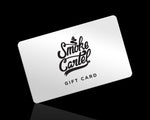Get blasted!
Your glass bong or water pipe can be customized with all kinds of logos and images. All of the possible visual effects you can achieve by abrasive blasting on glass can be broken down into 3 major techniques: surface etching, carving and shading.
Surface etching: So named because you are only etching the surface of the glass. In addition, this type of etching is all done in one stage of blasting, which means that the designs produced are all 2 element designs. That is, all the designs are positive and negative, or black and white.
The etched portions of the design almost always look white, and the clear, unetched portions of the design look black or dark. All etched elements have to be separated by spaces of unetched glass, or the etched elements blend together as a single silhouette, with no detail inside the border.
Surface etching is the easiest technique to learn and the fastest way to produce a finished etching on glass. The etched designs aren't as sophisticated as those from carving or shading.
Carving: Called carving because you actually blast deep into the glass, which gives a three dimensional etching. There are several types of carving, including single stage, two stage, multi-stage, and freehand carving.
Single stage carving is simply blasting a surface etching design deeply into the glass, separating elements with clear spaces, as in surface etching. With two stage or multi-stage carving, the resist is removed, not all at once, but a few elements at a time and in a definite sequence. This way, elements can be carved to different depths than the other elements they touch, yielding a 3-D bas relief carving.
Bot a regular bas relief, a reverse bas relief, since you are carving from one side of the glass and viewing the finished carving from the opposite (smooth) side! In other words, you are carving a hollow (or negative) shape in the glass that looks solid and positive from the smooth side.
Elements of a two stage or multi-stage carving design do not have to be separated from each other as they do in surface etching, because they are removed at different times and blasted to different depths. These different depths are what give the necessary visual separation between elements.
Shading: Like surface etching, this technique just blasts the surface of the glass. But unlike surface etching, the elements in the design are blasted to different apparent shades of gray (about 50, we'd say. Heheheheh.)
The principle of shading is that 100% clear glass usually appears dark while full surface etching appears 100% white. So you can create shades of gray by etching the surface to a density less than 100%, and you control the shade by controlling the density. Shading, like carving, can be done in one stage, two stage, multi-stage, and freehand techniques.
Elements of the shading design can all touch, as they can with a carving design, because the visual separations between elements are created by the stage blasting process. With shading, different shades of gray where elements touch rather than different depths as in carving. Shaded etching looks very much like airbrushing, with flowing tones of light and dark indicating shape and contour.
Combinations of techniques: Any etching can be produced with just one technique, but also by a combination of two or all three techniques.
For glass etchers who know all three techniques, this gives the ability to do the best and most sophisticated etchings possible. It is the ability to use each technique for its strengths and avoid its weaknesses. You can also get beautiful results by combining etching with other glass working techniques, like stained glass, glass blowing, etc.
Abrasives Used to Etch Glass
In order to etch glass, an abrasive has to be as hard or harder than the glass and the particles have to be rough, with sharp corners and edges. Glass beads don’t work well at all, since the beads are round and smooth. Sand works, since it is the same hardness as glass (glass is primarily made of sand) and the particles are rough, but there are three major problems.
- The sand dust from blasting is very hazardous to breathe, and can potentially cause silicosis, a fatal lung disease. If you use sand, you always have to wear a very good respirator and replace the cartridges regularly.
- Sand particles dull quickly, so they can’t be reused many times. This means you have to spend more money on replacing sand
- You can't get sand in a fine grit. The smallest particle size you can generally get with sand is about a 90 grit. Most etching these days is done with grit sizes of 120, 150 or finer, to give a beautiful, smooth finish to the etching. For awards and gifts, 180 to 220 is common. (The higher the number, the finer the grit.)
The best abrasive you can use is silicon carbide. While glass is rated between 4.5 and 6 on the Mohs hardness scale (depending on what type of glass), silicon carbide is a 9.5 (on a scale of 10, with 10 being diamond). It is reusable until the particles pulverize small enough to be sucked out of the system as dust. It is a little more expensive than aluminum oxide (the second choice) but not if you consider the cost per hour to use carbide, rather than the cost per pound.
Oxide is 9 on the Mohs scale, so it cuts fairly fast, but creates a lot of static electricity in the cabinet, which will constantly cause static shocks. In addition, the dust clings tenaciously to the back of the glass, making it difficult to see exactly what you are etching. This is very distracting when you are trying to use the shading technique.
The dust from both silicon carbide and aluminum oxide are considered to be "nuisance dusts" rather than a hazardous material as sand is, so they are both safer than using sand. Since both materials cost less than 80 cents per hour to use, carbide is the professional's choice for etching glass.























































































